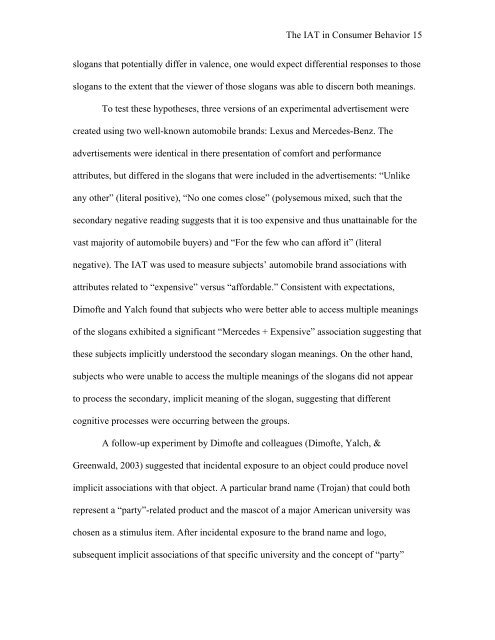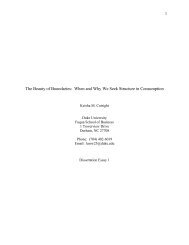RUNNING HEAD: The IAT in Consumer Behavior - Wharton Marketing
RUNNING HEAD: The IAT in Consumer Behavior - Wharton Marketing
RUNNING HEAD: The IAT in Consumer Behavior - Wharton Marketing
You also want an ePaper? Increase the reach of your titles
YUMPU automatically turns print PDFs into web optimized ePapers that Google loves.
<strong>The</strong> <strong>IAT</strong> <strong>in</strong> <strong>Consumer</strong> <strong>Behavior</strong> 15slogans that potentially differ <strong>in</strong> valence, one would expect differential responses to thoseslogans to the extent that the viewer of those slogans was able to discern both mean<strong>in</strong>gs.To test these hypotheses, three versions of an experimental advertisement werecreated us<strong>in</strong>g two well-known automobile brands: Lexus and Mercedes-Benz. <strong>The</strong>advertisements were identical <strong>in</strong> there presentation of comfort and performanceattributes, but differed <strong>in</strong> the slogans that were <strong>in</strong>cluded <strong>in</strong> the advertisements: “Unlikeany other” (literal positive), “No one comes close” (polysemous mixed, such that thesecondary negative read<strong>in</strong>g suggests that it is too expensive and thus unatta<strong>in</strong>able for thevast majority of automobile buyers) and “For the few who can afford it” (literalnegative). <strong>The</strong> <strong>IAT</strong> was used to measure subjects’ automobile brand associations withattributes related to “expensive” versus “affordable.” Consistent with expectations,Dimofte and Yalch found that subjects who were better able to access multiple mean<strong>in</strong>gsof the slogans exhibited a significant “Mercedes + Expensive” association suggest<strong>in</strong>g thatthese subjects implicitly understood the secondary slogan mean<strong>in</strong>gs. On the other hand,subjects who were unable to access the multiple mean<strong>in</strong>gs of the slogans did not appearto process the secondary, implicit mean<strong>in</strong>g of the slogan, suggest<strong>in</strong>g that differentcognitive processes were occurr<strong>in</strong>g between the groups.A follow-up experiment by Dimofte and colleagues (Dimofte, Yalch, &Greenwald, 2003) suggested that <strong>in</strong>cidental exposure to an object could produce novelimplicit associations with that object. A particular brand name (Trojan) that could bothrepresent a “party”-related product and the mascot of a major American university waschosen as a stimulus item. After <strong>in</strong>cidental exposure to the brand name and logo,subsequent implicit associations of that specific university and the concept of “party”




